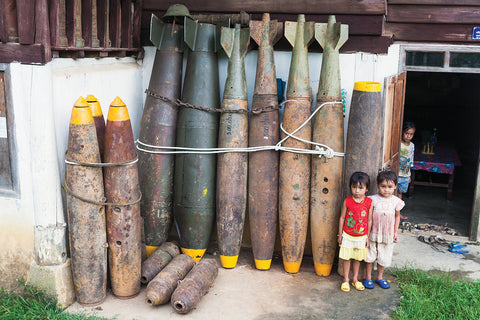
A Look at the Damage from the ‘Secret’ War in Laos
When Mark Watson and his partner Hana Black set off on a dream long-distance bicycling trip through Southeast Asia, they weren’t quite prepared for what they would find in Laos and Vietnam. Evidence of the Vietnam War was vividly apparent—in everything from the landscape to people’s farms, home decor, and innovations created from former weapons of war from decades past.
As a journalist, photographer, adventurer, and military history enthusiast, Watson is no stranger to harsh environments and former battlefields, but what he experienced on his journey caught him off guard. He was especially surprised by what he saw in Laos. “It’s remarkable how you can visit a place and be so blown away by what you’re seeing. As an adult who’s grown up reading books, watching the news and filling my mind with history, I could still go to a place like this in 2011 and witness something that’s far greater than anyone can imagine in terms of the impact it’s had on the land and people’s lives,” Watson told Vietnam magazine in an interview. “The country is so much living under the shadow of this carnage, and yet it’s not something you really hear about.”
Traveling from China into Laos, and from there into Vietnam, Cambodia, and eventually into Thailand, Watson rode along the Ho Chi Minh Trail and explored villages, noticing traces of UXO (unexploded ordnance) and documenting it in his photography. “It was an amazing adventure,” he said. “After I experienced this, I longed to go back, because there is just so much there to see.”
These external
fuel tanks in Laos were slung underneath aircraft and discarded into swamps
and jungles when emptied. “These have been recovered and turned into canoes,”
Watson said. “These are ubiquitous on the rivers, particularly in the poor
regions of Laos.”
War
relics are displayed at the entrance to a business in Laos near the border
with Vietnam.
"She’s holding what the locals call a ‘bombie’—which
is a cluster bomb,” explained Watson. “That one’s been defused. There’s
millions of these scattered through swamps, fields, and people’s tribal lands,
right through northern and eastern Laos. This was a pretty remote village.
They were surprised to see us, and very friendly.” Watson added that the Ho
Chi Minh Trail is extremely dangerous due to UXO. “You just don’t leave the
road. It’s not worth the risk.” While farming, local people sometimes “hit
these bombs accidentally, which blow up and take off a leg or an arm or kill
people.”
This cluster bomb canister in Laos has been used as a
planter. “As well as people using this material for scrap metal, there’s also
a burgeoning art scene where people are using bits of UXO and war scrap to
make artwork like bracelets, necklaces, and pieces of art for the home,” said
Watson.
Watson
saw enormous craters such as this one in Laos everywhere. “Something very
vivid in my memory is that, as we were going along the road, most of the
jungle had been destroyed by bombing and napalm….There were massive bomb
craters. You’d be riding along the road and there’d be three or four massive
craters on either side. Seeing those was really quite horrifying.”
These
cows in Laos wear bells formed from cluster bomb cylinders.
War
relics have been repurposed for Laotian house stilts and a ladder. “The houses
are elevated to help keep them cooler. This was something we saw cluster bomb
cylinders used for a lot,” noted Watson.
“Since I was a boy I’ve had more than a passing interest in war history, so I was very aware of what took place in Vietnam during the war, but not so much in regard to Laos," said Watson. "I had no idea there was still so much evidence of what took place there during the ’60s and ’70s.”
